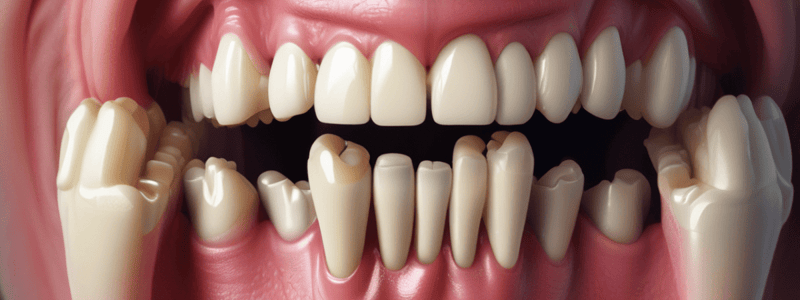Podcast
Questions and Answers
What is the primary etiologic agent of both gingivitis and periodontitis?
What is the primary etiologic agent of both gingivitis and periodontitis?
- Dental biofilm (correct)
- Genetic factors
- Systemic diseases
- Viruses
What effect do bacterial toxins have on the epithelial barrier in the context of neutrophil passage?
What effect do bacterial toxins have on the epithelial barrier in the context of neutrophil passage?
- They repair the barrier
- They make the barrier more permeable (correct)
- They strengthen the barrier
- They keep the barrier intact
Which pattern recognition receptors do oral epithelial cells express to detect various bacteria?
Which pattern recognition receptors do oral epithelial cells express to detect various bacteria?
- CD4 and CD8
- NOD1 and NOD2 (correct)
- IL-1 and IL-8
- TLR4 and TLR6
What is a characteristic feature of periodontitis?
What is a characteristic feature of periodontitis?
Which cytokines are implicated in the development of periodontitis?
Which cytokines are implicated in the development of periodontitis?
What components are activated upon contact with biofilm bacteria during the immune response?
What components are activated upon contact with biofilm bacteria during the immune response?
What happens to C3a and C5a after they are released from the complement system?
What happens to C3a and C5a after they are released from the complement system?
What characteristic does the attached gingiva exhibit upon exposure to bacteria?
What characteristic does the attached gingiva exhibit upon exposure to bacteria?
What type of bacteria does NOD1 specifically detect?
What type of bacteria does NOD1 specifically detect?
What role do neutrophils play in the response to biofilm pathogens?
What role do neutrophils play in the response to biofilm pathogens?
Flashcards are hidden until you start studying
Study Notes
Immunopathogenesis of Periodontal Disease
- Keratinized attached gingiva decreases keratin expression when exposed to bacteria.
- Periodontitis is marked by significant bone loss, which can lead to tooth loss.
- Dental biofilm serves as the etiologic agent responsible for initiating both gingivitis and periodontitis.
- Oral epithelial cells possess all 10 types of Toll-like receptors (TLRs) that identify bacterial patterns, triggering the release of IL-1 and IL-8, which are associated with periodontitis.
- Epithelial cells also have NOD1 and NOD2 receptors; NOD1 identifies gram-negative bacterial cell walls, while NOD2 detects both gram-positive and gram-negative wall components.
- The immune response activates to combat biofilm pathogens using various defense mechanisms:
- Complement proteins are present in the gingival crevicular fluid within the gingival sulcus.
- Activation of the complement system occurs upon engagement with biofilm bacteria, leading to anaphylatoxins C3a and C5a being released.
- C3a and C5a act as signaling molecules, recruiting immune cells like neutrophils into the gingival sulcus.
- For neutrophils to infiltrate the sulcus, the epithelial barrier must increase in permeability, a process exacerbated by bacterial toxins damaging the epithelium.
- Biofilm bacteria exhibit resistance to changes in pH, complicating host immune responses.
Studying That Suits You
Use AI to generate personalized quizzes and flashcards to suit your learning preferences.




